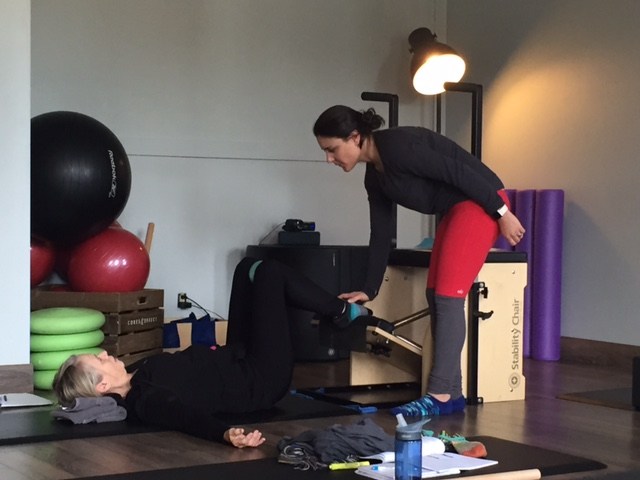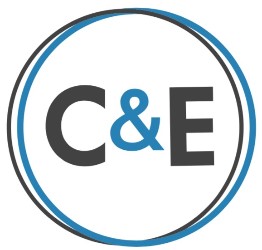
This second weekend of TT, we arrive knowing a little more of what to expect. And we’ve had tons of studio time to get comfortable with at least one additional piece of apparatus. We’ve come a long way from our first pseudo-apparatus (the 2×4) and we’d like to think we are now more accomplished at the Reformer beginner repertoire. We’ve even practiced teaching it to each other, knowing what to look for and how to modify. Also we’re getting practice and feedback from the scripts of our pre-Pilates release work warmups.
Still so much to know, judging from the volume of material added on Friday night: more teacher manuals for The Cadillac and The Chair.
Although not fond of the name (Wunda-Chair) that Joe Pilates gave his invention, it seems hard to quibble with its design or versatility or value and its many effective variations (baby chair, high or electric chair, hybrids, with or without handles); I’d like the original one in my living room! Since it was one of the many tools Amy used in my lessons, I’d already glimpsed its potential but Tanis spent much of the day demonstrating more of its extensive repertoire, its challenges and its adaptability. Several of our group concluded that it would be the first apparatus they would buy and use, even ahead of the ubiquitous Reformer, because it was so small yet so mighty. So few people apparently know how to effectively use it, Tanis even advised checking out second-hand ones.
Our weekend also included the intro to the also appropriately named Cadillac/Trapeze, the last of the major pieces of apparatus that were designed to support all bodies to learn Pilates properly and safely. Together the apparatus will get us ready to eventually tackle it all on the mat –- without support! Although the Cadillac was first developed as a tool for rehab work, and isolating and supporting joints, it has many bells and whistles for advanced work, too. We’ll be sticking to basics for a while, however, to get familiar with the many attachments and positions that make it such a versatile apparatus and so good for teaching on. Since it’s also considered the most dangerous, we spent a lot of time on safety and contraindications. And like always, see how the concepts of scoop, two-way stretch, connect, gripping, etc. transfer from one apparatus to the next.
As with most training, not all of it will come from workshops or manuals but with experience; we are here mainly to expedite the process by learning from the masters in Classical Pilates. We may all intellectually understand there’s a purpose in shaping the body a certain way, but we must experience (or as Tanis says, “feel it in our bodies”) to really understand and teach it. How well we do our own foundational work is key to any progress or progression, we’re reminded. But we don’t have to be reminded that maybe the best of all worlds is learning in conjunction and immersion with others on similar paths? Corinne calls it “fertilizing” within our new “tribe.”
We are certainly starting to feel more at home in this country of Pilates, and anatomy is becoming a second language. We find ourselves integrating rhomboids and lateral planes into our practice like athletes with their sport-specific lingo. However, us athletes still find Pilates movement patterns can be incredibly challenging and counter-intuitive to what perhaps came easy before.
One of our group is neither new to fitness or teaching but she is the newest recruit to Pilates. (Somewhat unusual for teacher-training (TT) program; usually TTs build on many many hours of pilates practice before they decide they can and want to teach it.) As she discovers concepts new to her that address the symptoms of a typical dysfunctional, myofascially tight body, the rest of us find ourselves constantly reminded of our own similar journeys and lightbulb moments. And that’s a good thing –because we truly can, and must, empathize with future rookies.
One of the best examples and teachable moments happened during the Rollup on the Cadillac. As we took our turns trying to mimic Tanis’s perfect demo, we sweated, groaned and moaned about how imperfect we felt/looked in comparison but also how much harder work it was than it looked. Was that a smirk (maybe a little one?) on Tanis’ face? Were we really getting “it”? Yes, the depth and difficulty of a Pilates workout should rival any other type we’ve ever known, she agreed. If we go slowly and mindfully (in contrast to addictive more aerobic-type workouts) we will be working the whole body (not just the fast twitch muscles) and build the strong muscle, joint and spine foundations necessary for our life, work and sport. By the end of the weekend, the three experienced observers independently remark that all our bodies seem to be moving better. We, too, can feel that the three days’ hard body and brain work has all been worth it.
The following week’s self-practice sessions feel richer and more layered. There are more exercises in the repertoire to repeat and spring tension settings to remember. We are quickly humbled by the additional apparatus, though, when it comes to practicing without the cues of an experienced teacher. Stomach massage? Short box? Hand positions variation? Knee adaptations? It’s back to our notes to refresh and review, because after this week, the group will be adding Practice Teaching. Health questionnaires and lesson plans will have to be vetted with supervisor and role model Amy first, of course. Baby steps for us — and for the guinea pigs. First come the deep breaths…
